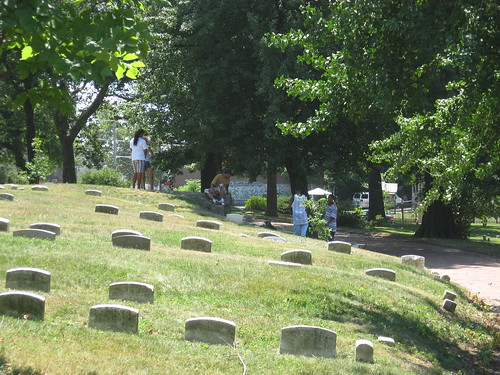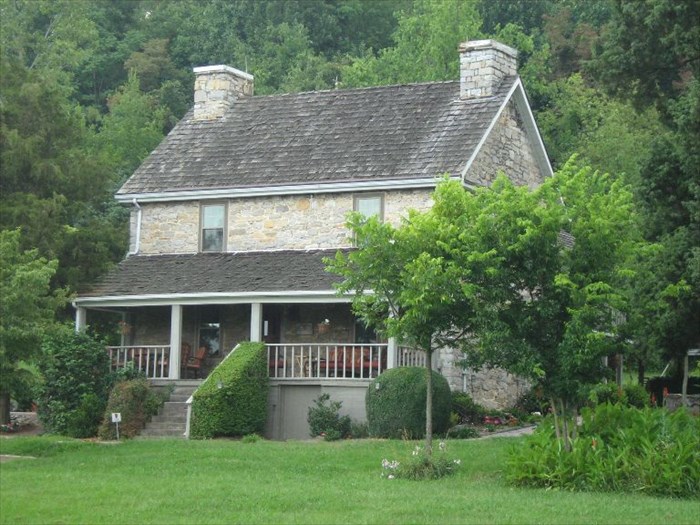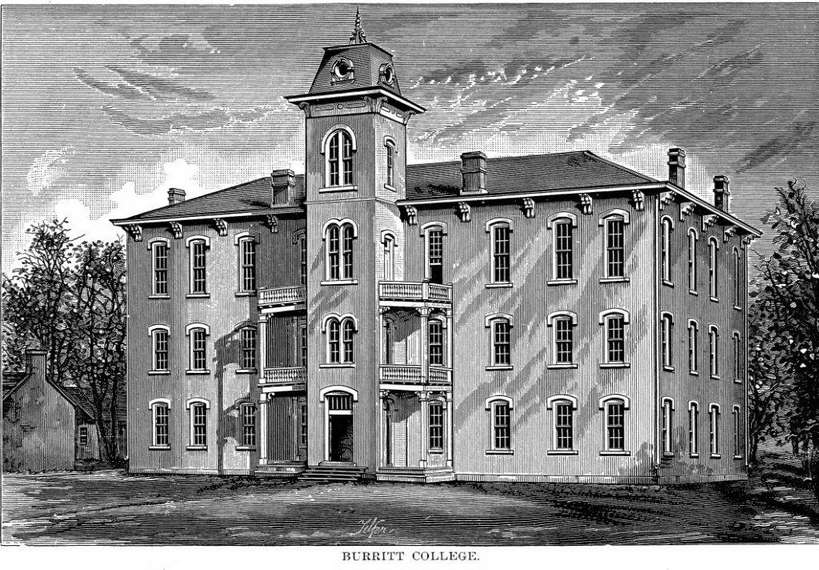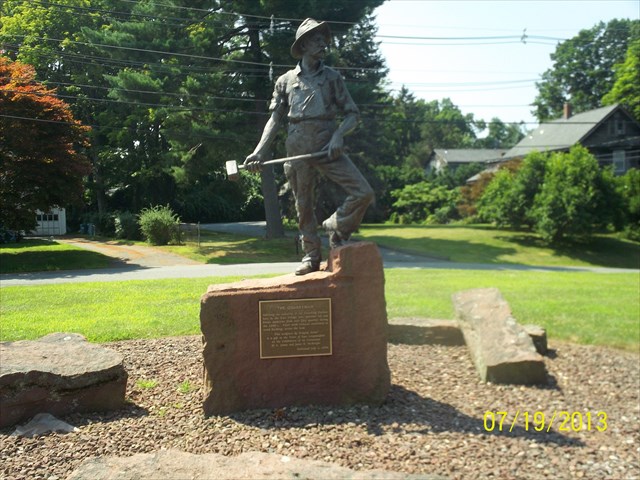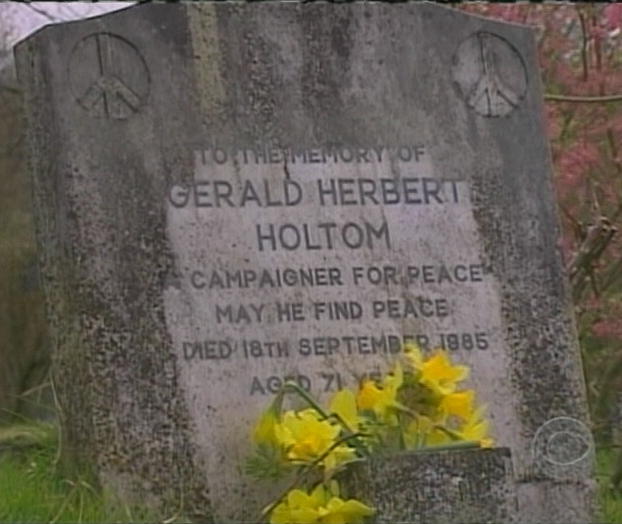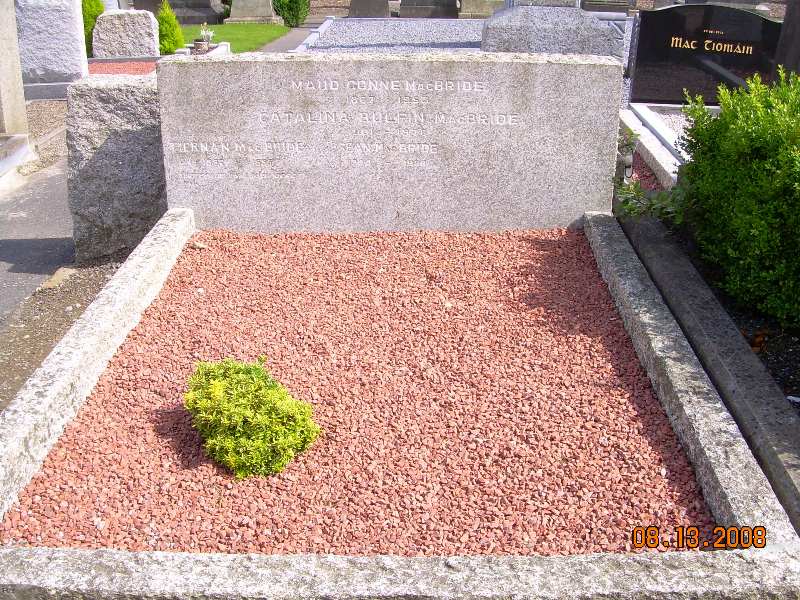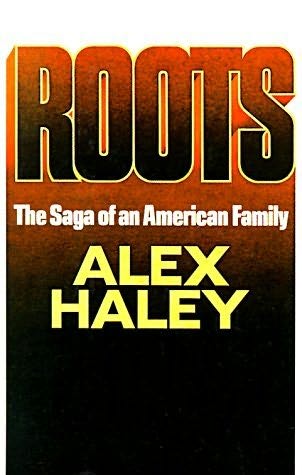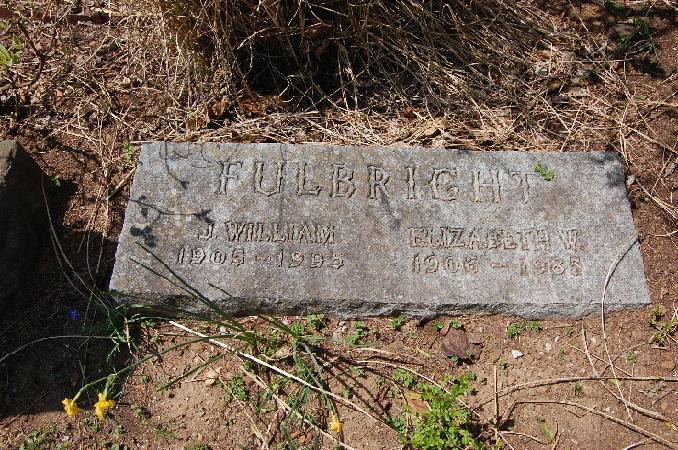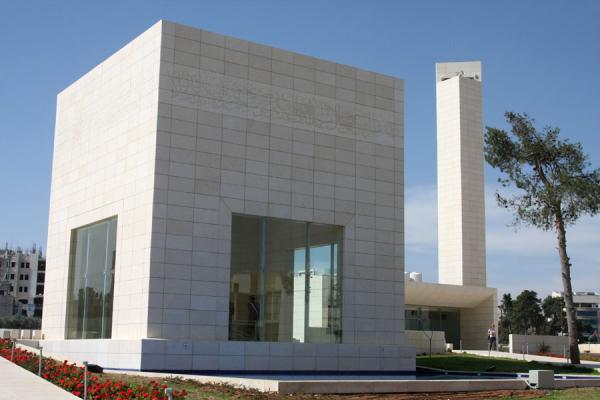


Graves & Tombs of
61 Notable PeacemakersClick here for peacemakers.
Right click image to enlarge.
Sérgio Vieira de Mello
![]()
Date? - Plainpalais Cemetery, Rue Des Rois, Geneva (Switzerland). "A peaceful oasis in the center of the city... The final resting place of many of Geneva's most prominent citizens including John Calvin, James Fazy, Augustin de Candolle, Henri Dufour & Sergio Vieira de Mello [1948-2003], the late UN High Commissioner for Human Rights... Filled with interesting gravestones dating back to 1482."

Jews of Worms
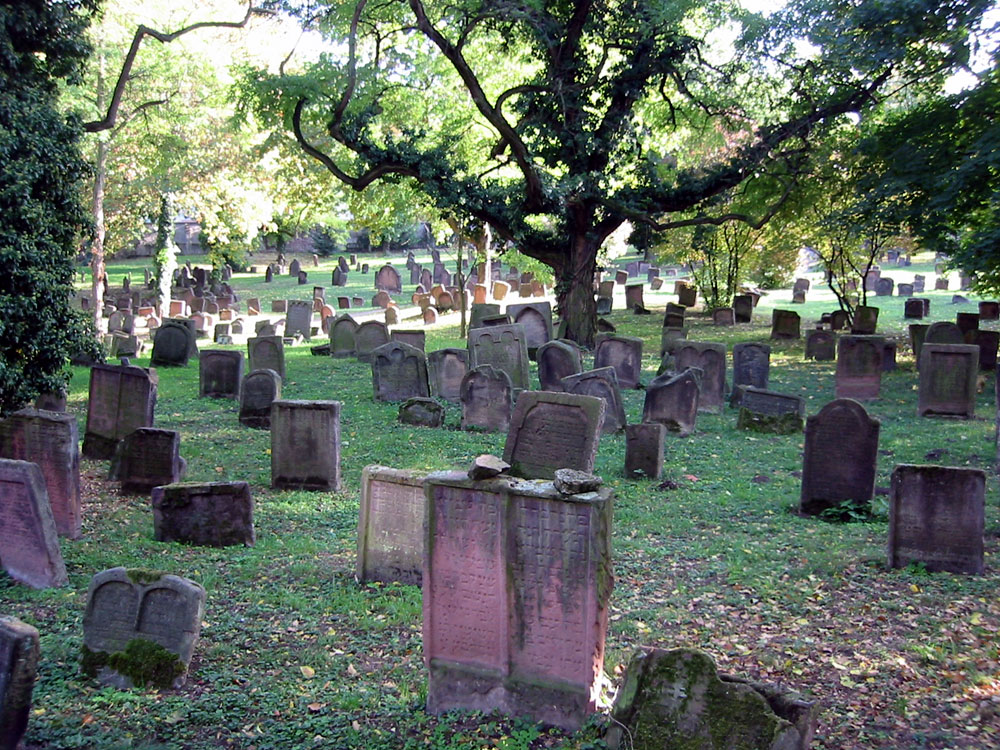

About 1059 - Heiliger Sand / Jewish Cemetery, Worms (Germany). Date is the oldest tombstone still legible. Cemetery is "usually called the oldest surviving Jewish cemetery in Europe (although the Jewish burials in the Jewish sections of the Roman catacombs predate it by a millennium). The Jewish community of Worms was established by the early 11th century. The older part contains still about 1300 tombstones, the newer part (on the wall of the former city fortifications), acquired after 1689, more than 1200." Survived the Nazi era. /// "The other notable Jewish site in Worms is the Rashi synagogue, which dates from 1175 & is named after the famous medieval Torah commentator who spent a part of his career there. In the adjoining museum devoted to the history of the Jews of Worms, there is a chilling photograph of the synagogue going up in flames during Kristallnacht in 1938 when much of the Jewish Quarter was destroyed. The local fire brigade is on the scene & firefighters can be seen aiming their hoses directly away from the synagogue to protect nearby German homes & buildings."
Desiderius Erasmus
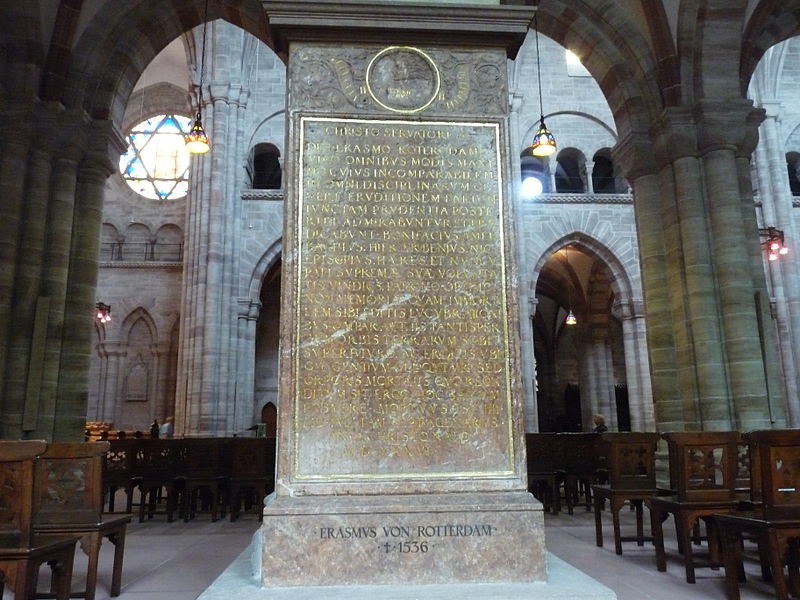
1536? - Tomb of Erasmus, Basler Münster / Basel Minster, Münsterplatz, Basel (Switzerland). Desiderius Erasmus [1466/1469-1536] was a Dutch Renaissance humanist. "He spent several years in Basel and died here in 1536. Although he stayed a Roman Catholic, he was buried in the Minster that was by then the main church of the Protestants in Basel. His bones were lost following changes to the church during the 19th century. They were only positively re-identified in 1974 and now rest under his epitaph." Information courtesy of Gerard Lössbroek.

George Fox
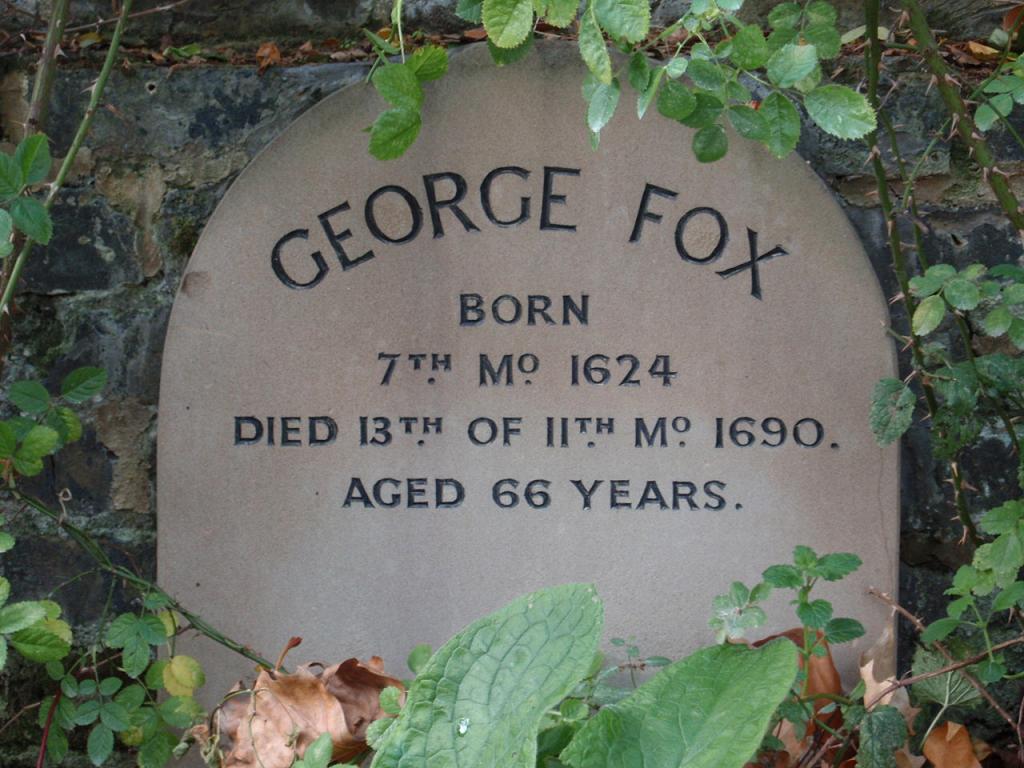

About 1691 - Grave of George Fox, Quaker Gardens, beteeen Chequer & Banner Streets, London (England). In the remaining part of a Quaker burial groaund dating from 1661. George Fox [1624-1691] was an English Dissenter & a founder of the Religious Society of Friends, commonly known as the Quakers. "In keeping with Quaker beliefs in plainness & modesty, his grave has only a simple marker." 1 of 45 monuments in "Peace Trails through London" by Valerie Flessati (2012), page 14.



1872 - George Fox Memorial, George Fox Lane, Fenny Drayton (England). At birthplace of George Fox [1624-1691]. Click here for Quaker peace monuments worldwide.

Quaker Cemetery
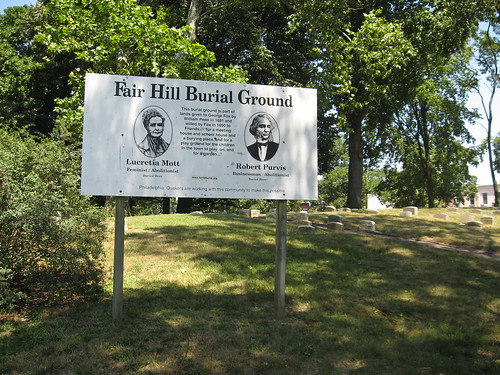


1703 - Fair Hill Burial Ground, 2900 Germantown Avenue, Philadelphia, Pennsylvania (USA). "Founded in 1703 on part of a grant of land of 16 acres given to the Religious Society of Friends (Quakers) by George Fox [1624-1691], who is known as the founder of the Society. He received the land from William Penn [1644-1718] as a gift. The present burial ground was laid out in 1843 and enlarged in 1853, providing almost five acres of green space in this urban neighbohood. Most persons buried at Fair Hill are Quakers, many of them participants in the early abolitionist and women's rights movements. Some of the more renowned include Lucretia Mott [1793-1880], James Mott, Thomas and Mary Ann McClintock, Sarah Pugh, Ann Preston and Edward Parrish. Some colleagues in the anti-slavery movement, not Friends, are also buried there, most notably Robert Purvis [1810-1998], an African-American known as the President of the underground railroad, and his family. The site was recently placed on the National Register for Historic Places."

John Newton
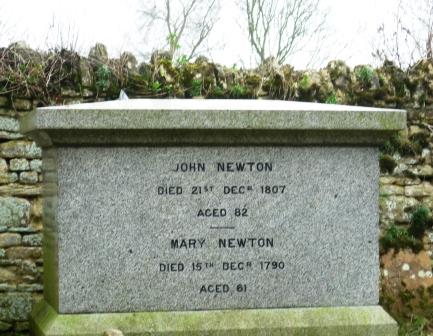


About 1807 - Newton's tomb & Stained glass window depicting the 'Greyhound,' Parish Church of St. Peter & St. Paul, Olney, Milton Keynes, Buckinghamshire (England). One of a series of stained glass windows depicting the ship "Greyhound." John Newton [1725-1807], a one time slaver, underwent religious conversion & conversion to the anti-slavery cause. His near shipwreck on the 'Greyhound' which found refuge in Londonderry (Northern Ireland) in 1748 played a part in this process. He went on to write ‘Amazing Grace.’" /// ". The Vicarage was occupied by John Newton as Curate from 1764 until 1780, when he moved to London, becoming Rector of St. Mary Woolnoth. A dormer window belongs to the study where he wrote Amazing Grace. The church contains Newton's pulpit & fine stained glass windows commemorating William Cowper [1731-1800] & Newton. In the churchyard are the graves of Newton & his wife Mary, with an interesting inscription describing himself as 'once an infidel and libertine, a servant of slaves in Africa...'" When was the window created?
Elihu Embree
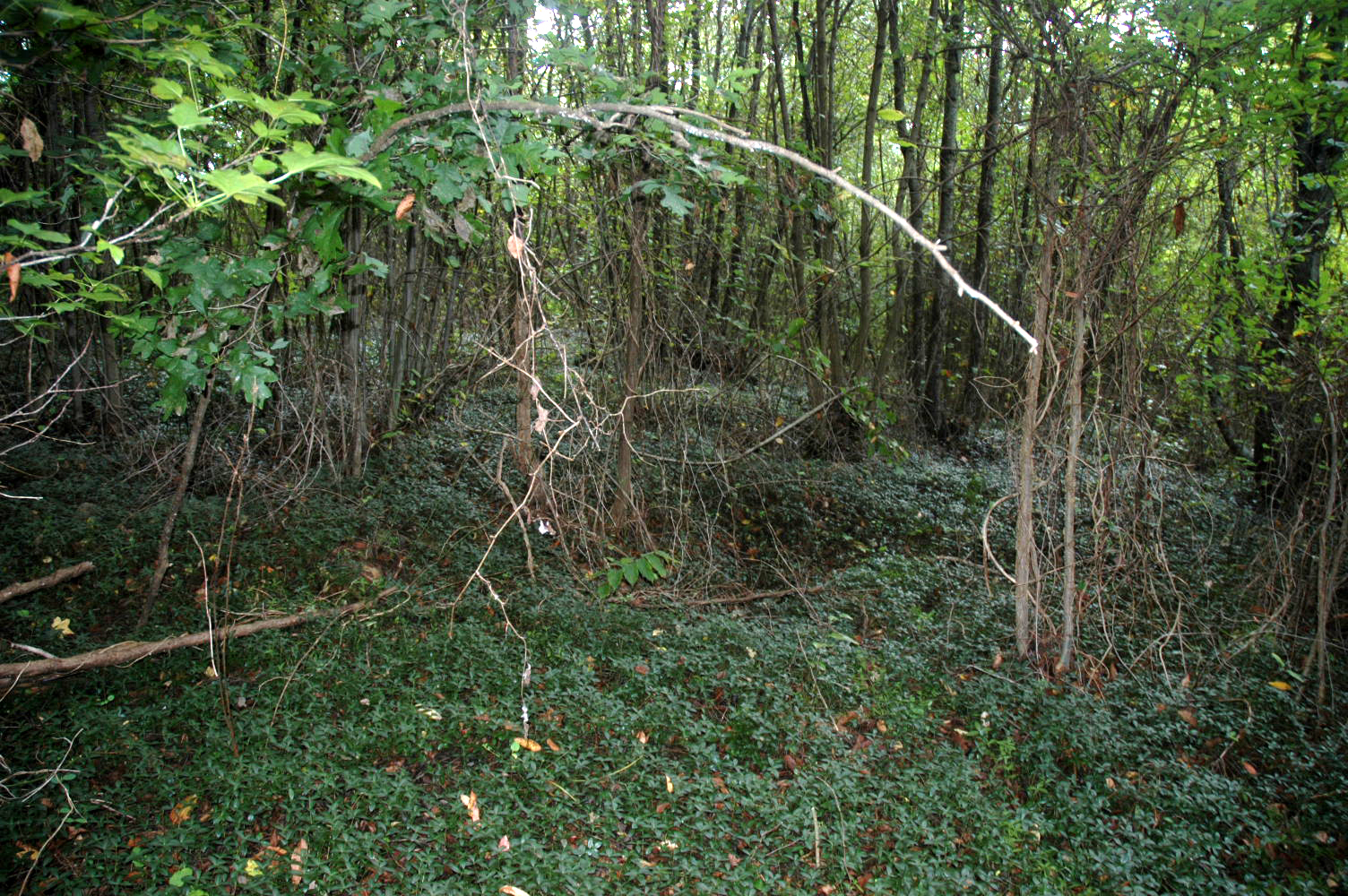
G
RA
V
E
1820 - Grave of Elihu Embree, Embree Family Cemetery, Jonesborough, Tennessee (USA). Embree died at age 38. Cemetery is "very overrun but can be walked." /// Lower image is "First Abolitionist Publications" marker in Jonesborough honoring Quaker Elihu Embree [1782-1820] who published the first newspaper in the USA dedicated entirely to the abolition of slavery.


H
OU
S
E
1820 - Home of Elihu Embree [1782-1820], 142 Matthews Mill Road, Telford, Tennessee (USA). About 6 miles west of Jonesborough. Unintentional monument. Constructed about 1791. Was a hiding place for runaway slaves. Originally faced north. Upper image shows porch added to south side. Lower image shows basement once occupied by slaves. Privately owned.

M
A
RK
E
R
Date? - "Thomas Embree Marker," Highway 353, near Telford, Washington County, Tennessee (USA). Points to home of Elihu Embree. Photo by EWL 05July2015. /// Lower image is "The Emancipator" (with introduction by Ella Pearce Buchanan & John F. Nash), Embreeville Publications, Jonesborough (1995), which contains reprints of Embree's newspaper.

William Ellery Channing, Dorothea Dix, Julia Ward Howe & Mary Baker Eddy
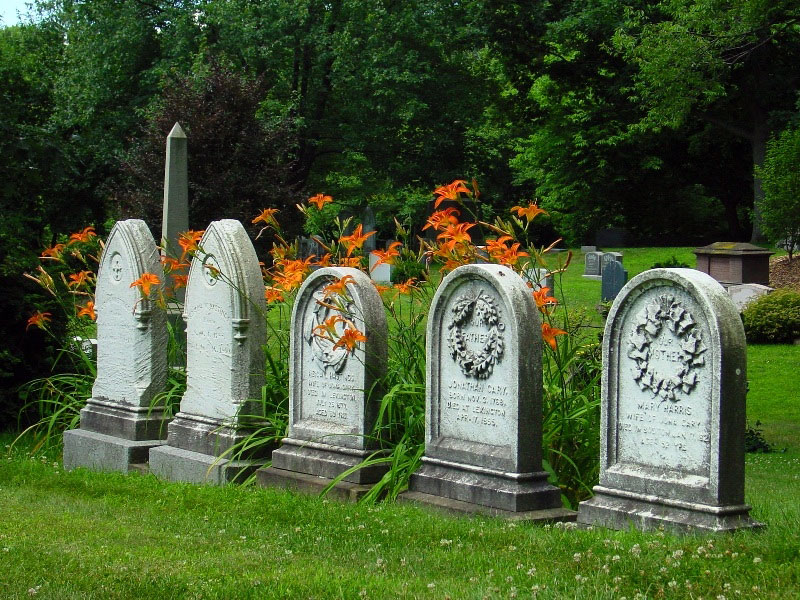

1831 - Mount Auburn Cemetery, 580 Mount Auburn Street, Cambridge, Massachusetts (USA). "Our founders believed that burying and commemorating the dead was best done in a tranquil and beautiful natural setting at a short distance from the city center. They also believed that the Cemetery should be a place for the living, 'embellishing' the natural landscape with ornamental plantings, monuments, fences, fountains and chapels. This inspired concept was copied widely throughout the United States, giving birth to the rural cemetery movement and the tradition of garden cemeteries. Their popularity led, in turn, to the establishment of America's public parks." Famous people buried here include William Ellery Channing [1780-1842], Dorothea Dix [1802-1887], Julia Ward Howe [1819-1897] and Mary Baker Eddy [1821-1887].
Jean-Jacques de Sellon


1839 - Marble Obilisk, Cemetiere du Petit-Saconnex, chemin Moise-Duboule 12, Le Petit-Saconnex, near Geneva (Switzerland). Erected by Count Jean-Jaques de Sellon [1782-1839] in 1832 on his estate La Fenêtre (which now belongs to the United Nations) in Pregny, but it was transferred in 1907 to the nearby cemetery where he is buried. Inscriptions: "Heureux ceux ui procurent la paix car ils seront appelles enfants de dieu." "Dieu ne veut pas la mort du pecheur mais sa conversion et sa vie." "La Societe de la Paix fut fondee le 1er Decembre 1830 par J.J. de Sellon, Citoyen de Geneve, Comte du St Empire. Il consacra ce monuent a l'inviolabilite de la vie de l'homme l'an 1832." Also bears the names of advocates of peace & of the abolition of the death penalty: William Penn, Casimir Perrier, Livingson, Nicholas de Flue, William Wilberforce, Elisabeth (the queen?), the US states of Maine & New Hampshire (ont aboli la peine de mort l'an 1837 [sic]), Duke Leopold of Tuscany, Victor de Tracy, Charles Lucas, Cesare Beccaria, Grohmann, Fredericc Guillaume of Prussia, Henry IV of France, the Duke of Sully, Fenelon & the Duke of Sussex. ALL information about this monument is from "Itinerary for Peace in the Streets of Geneva" (August 2002), pp. 102-3. Image shows the cemetery but NOT the monument.
William Wilberforce

1840 - Statue of William Wilberforce, North & South Choir, Westmnster Abbey, London (England). William Wilberforce [1759-1833] was a leader of the movement to abolish the slave trade. Image shows Queen Elizabeth at the statue just before a service in March 2007 marking the 200th anniversary of the abolition of the slave trade. One of 309 London monuments in Kershman (2007), page 83.


Date? - Wilberforce University, Tawawa Springs, Wilberforce, Ohio (USA).
Jeremy Bentham

1850 - "Auto-Icon" of Jeremy Bentham, University College London (UCL), London (England). In glass-fronted cabinet. Jeremy Bentham [1748-1832] was a philosopher who campaigned for social and political reform [and mentor of Frances Wright]. His utilitarian principles helped him to create the greatest happiness principle & calculus. He requested in his Will that his body should be preserved & in a wooden cabinet which he called his "Auto-Icon." UCL acquired his body in 1850 and have kept it on public display ever since. The Auto-Icon has a wax head; the real head is in a mummified-state locked away in the university. Click here for video. Information courtesy of Hope May 08Feb13.
Frances Wright
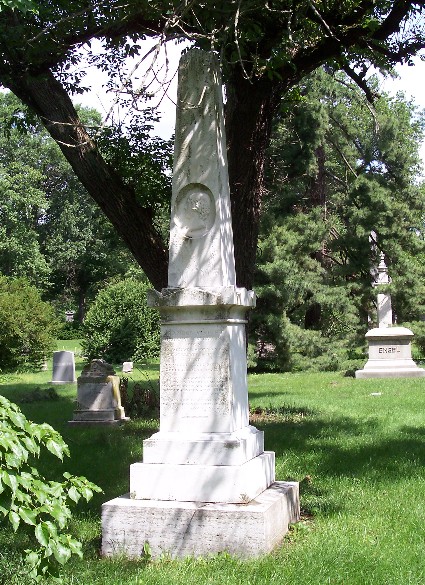



After December 13, 1852 - Grave of Frances Wright, Spring Grove Cemetery, 4521 Spring Grove Avenue, Cincinnati, Hamilton County Ohio 45232 (USA). Frances (Fanny) Wright [1795-1852] was "a Scottish-born lecturer, writer, freethinker, feminist, abolitionist & social reformer [& mistress of the Marquis de LaFayette], who became a US citizen in 1825. That year she founded the Nashoba Commune in Germantown, Tennessee, as a utopian community to prepare slaves for emancipation, intending to create an egalitarian place, but it lasted only three years. Her 'Views of Society & Manners in America' (1821) brought her the most attention as a critique of the new nation."



1950's - Nashoba Marker, Germantown, near Memphis, Tennessee (USA).
Robert Owen
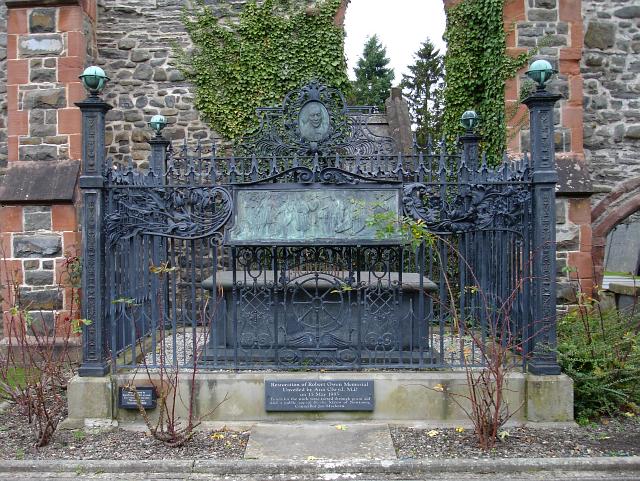

After November 17, 1858 - Tomb of Robert Owen [1771-1858], Newtown, Montgomeryshire (Wales).


Date? - New Lanark Mill, New Lanark (Scotland). World Heritage Site.


Date? - Marker, New Harmony, Indiana (USA).
Thomas Hodgkin
G
R
A
V
E1866 - Grave of Dr. Thomas Hodgkin, Jaffa (Israel). "Dr. Thomas Hodgkin [1798-1866] "was a a pioneer in preventive medicine...best known for the first account of Hodgkin's disease... He was born to a Quaker family in Pentonville, St. James Parish, Middlesex (England)... He accompanied his close friend [Jewish philanthropist] Sir Moses Montefiore [1784-1885] to Palestine, contracted dysentery, died on 4 April 1866, and was buried in Jaffa." /// Dr. Hodgkin was a great uncle of Quaker medical missionary Henry Theodore Hodgkin [1876-1933] who founded the Fellowship of Reconcilation (FOR) in the UK 1914, founded FOR in the USA in 1915 & served as the first director of Pendle Hill, the Quaker "center for study and contemplation" in Wallingford, Pennsylvania (USA).


Abraham Lincoln


1874 - Lincoln's Tomb, Oak Ridge Cemetery, Springfield, Illinois (USA). Includes reproductions of Lincoln statues in Chicago & Washington, DC. Mary Todd Lincoln and sons Tad, Willie & Eddie are also buried here, but not son Robert (who is buried in Arlington National Cemetery). Abraham Lincoln [1809-1865] was US president 1860-1865 & signed the Emancipation Proclamation in 1862.
Robert Dale Owen


1877 - Grave of Robert Dale Owen, Maple Hill Cemetery, New Harmony, Indiana (USA). Son of Robert Owen (qv) & born in Scotland, Robert Dale Owen [1801-1877] was a reformer & writer. He was a passenger on the Boatload of Knowledge in 1825-1826 & helped Frances Wright (qv) at her Nashoba colony in Tennessee. Together they published the "New Harmony Gazette" in New Harmony & later the "Free Inquirer" in New York City. Elected to the US Congress, Owen sponsored the bill which created the Smithsonian Institution. He died at his summer home on Lake George, New York, but was reintered in New Harmony.

Elihu Burritt

G
R
A
V
EM
E
M
O
R
I
A
L
1879 - Grave of Elihu Burritt, Fairview Cemetery, New Britain, Hartford County, Connecticut (USA).

1916 - Elihu Burritt Memorial, 111 Franklin Square, Sister City Plaza, New Britain, Connecticut (USA). Says "Peace and Universal Brotherhood." Sculpted by Robert Aitken [1878-1949]. Restored in 2000.
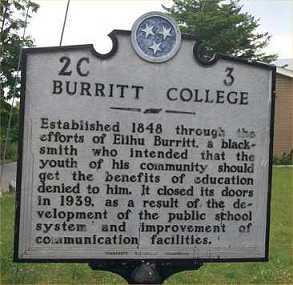
C
OL
L
E
G
EM
A
RK
E
R
1848 - Burritt College, Spencer, Van Buren County, Tennessee (USA). Closed in 1939, but at least one building is still used by county government. "Founders chose the name of Elihu Burritt [1810-1879] because they admired the initiative, perseverance & determination which characterized Burritt's rise to national prominence. While there was not an overwhelming amount of pacifistic sentiment within the Church of Christ, there was nevertheless a sufficient amount for the small band of Christians in the isolated village of Spencer to know of the life and work of one of the outstanding leaders in the peace movement. Generally the Church of Christ followed the pattern set by other religious groups in questions such as war & slavery."

S
T
A
T
U
EM
E
M
O
R
I
A
L
August 13, 1908 - Elihu Burritt Memorial, The Green, New Marlborough, Massachusetts (USA). Inscribed "'The Learned Blacksmith.' Linguist and Apostle of Peace. Organizer of 'the League of Universal Brotherhood.' Author of the "Congress of Nations.' Advocate of low rate ocean postage. Followed his trade and studied at the Forge in New Marlboro 1821-1833."
Lucretia Mott



After November 11, 1880 - Grave of Lucretia C. Mott, Fair Hill Burial Ground, Philadelphia, Philadelphia County, Pennsylvania (USA). Lucretia Coffin Mott [1793-1880] was an American Quaker, abolitionist, a women's rights activist & a social reformer. She helped write the Declaration of Sentiments during the Seneca Falls Convention in 1848.

Caterina Campodonico



1881 - Grave of Caterina Campodonico, Cemetery of Staglieno, Genoa (Italy). "Campodonico was a pauper nuts-seller, who saved money for her whole life to afford a luxurious grave. However, the statue realistically portrays while she sells her humble merchandise. This is one of the most popoular statues in the cemetery." Inscription: "By selling my wares at the Sanctuaries of Acqucsanta Garbo and St. Cipriasso, defying wind, sun and ___ in order to provide an honest loaf for my old age, I have also put by enough to have myself placed later on, with this monument, which I Caterina Campodonico (called the Peasant) have erected while still alive. 1881. Oh, you who pass close to this, my tomb, if you will, pray for my peace."
Henry Richard


About 1888 - Grave of Henry Richard, Abney Park Cemetery, Stoke Newington, London (England). In a nonconformist cemetery. Henry Richard [1812-1888] was a Congregational minister & Welsh Member of Parliament 1868-1888. He advocated peace & international arbitration, was secretary of the Peace Society for 40 years 1848–1884, and was known as "the Apostle of Peace." Info courtesy of Valerie Flessati (2012). This is 1 of 45 monuments in her "Peace Trails through London," page 17.

August 18, 1893 - Henry Richard Statue, Tregaron, Cardiganshire (Wales). By Albert Toft." Henry Richard [1812-1888] was born in Tregaron. He was a Nonconformist minister in London before being elected the Liberal Member of Parliament for Merthyr Tydfil in 1868. He was known as 'The Apostle of Peace' in recognition of his work as secretary of the Peace Society [1848-1884]." One of 13 sites on the MAW Peace Map of the British Isles as of January 2009. (N.B.: "Apostle of Peace" also used on plaque for W.T. Stead [1849-1912] in Embleton (England).)
Haymarket Activists
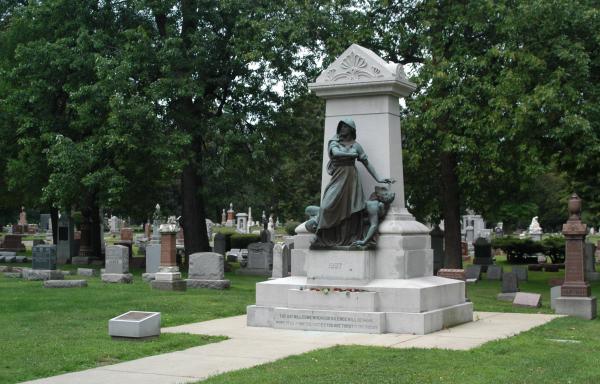
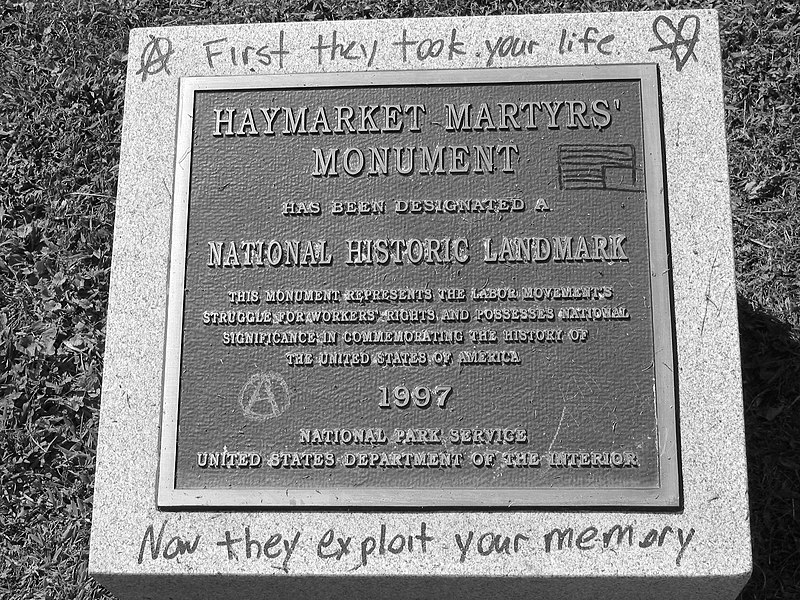

1893 - Haymarket Martyrs' Monument, Forest Home/German Waldheim Cemetery, 863 South DesPlaines Avenue, Forest Park, Chicago, Illinois (USA). "The labor activists executed for their alleged role in the 1886 Haymarket Square bombing are buried here; their striking grave monument has become a magnet for labor leaders, activists, and anarchists from around the world. The monument, designed by Polish-born Albert Weinert [1863-1947] and dedicated in 1893, was designated a National Historic Landmark in 1997" (the only cemetery memorial so recognized). Emma Goldman (qv) is buried nearby.
Frederick Douglass



G
R
A
V
E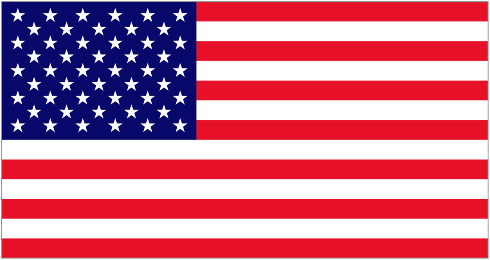
After February 20, 1895 - Grave of Frederick Douglass, Mount Hope Cemetery, Rochester, New York (USA). On February 20, 1895, "Douglass attended a meeting of the National Council of Women in Washington, DC. During that meeting, he was brought to the platform & given a standing ovation by the audience. Shortly after he returned home, Frederick Douglass died of a massive heart attack or stroke. His funeral was held at the Metropolitan African Methodist Episcopal Church where thousands passed by his coffin paying tribute." Buried near Susan B. Anthony (qv).
Ulysses S. Grant
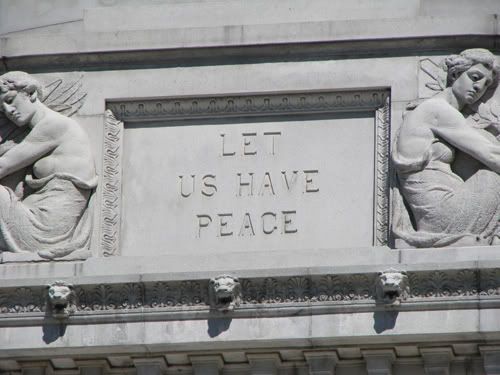
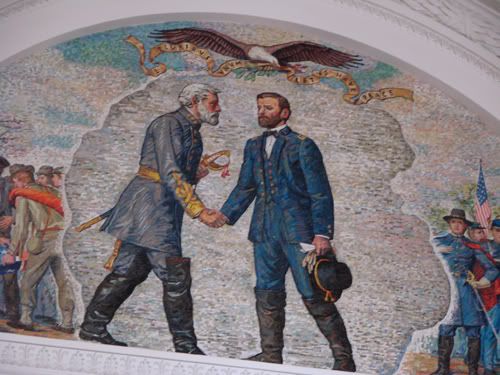
T
OM
B
April 27, 1897 - Grant's Tomb, Morningside Heights , New York City, New York (USA). "The largest mausoleum in North America. The bodies of Ulysses S. Grant [1822-1885], the Union Civil War General & 18th President of the U.S., and his wife Julia Dent Grant are entombed there. The phrase 'Let us have peace' greets visitors at the entrance of the mausoleum. It is taken from Grant’s words in his 1885 memoirs. Inside, there’s a mural of the two generals [Lee & Grant] shaking hands."
Henry George


1897 - Grave of Henry George, Green-Wood Cemetery, Brooklyn, New York City, New York (USA). George's funeral in 1897 was attended by more people than any other funeral in US history except for that of President Abraham Lincoln. Henry George [1839-1897) was an American writer, politician and political economist, who was the most influential proponent of the "Single Tax" on land.
Hugo Grotius



W
R
E
A
T
HJuly 4, 1899 - Silver Wreath on Tomb of Hugo Grotius [1583-1645], Nieuwe Kerk/New Church, Delft (Netherlands). Laid by US delegation to the 1899 Hague Peace Conference. Inscribed in English: "To the Memory of Hugo Grotius / In Reverence and Gratitude / From the United States of America / on the occassion of the International Peace Conference in The Hague / July 4, 1899." Right image shows Dr. Arthur Eyffinger (author of numerous books on The Hague & Peace Palace) & American professor Hope Elizabeth May who cleaned the wreath for the first time in 113 years & caused it to be rdedicated it on July 4, 2012. Left & middle images are from a 1899 book which Prof. May found at the US Library of Congress. Click here for video of the rededication. All images & info courtesy of Prof. May 07Feb13.

Robert Green Ingersoll

After July 21, 1899 - Grave of Robert Green Ingersoll [1833-1899], Arlington National Cemetery (Section 3, Grave 1620), Arlington, Virginia (USA).
S
TA
T
U
E
October 28, 1911 - Statue of Robert G. Ingersoll, Glen Oak Park, Peoria, Illinois (USA). From the New York Times: "Oct. 28 -- In the presence of a great crowd a memorial statue of Col. Robert G. Ingersoll [1833-1899], the lecturer & freethinker, one of Peoria's most noted men, was unveiled this afternoon by Robert G. Ingersoll Brown of New York City, a grandson."
M
US
E
U
M
1921 - Robert Green Ingersoll Birthplace Museum, Dresden, New York (USA). Closed, then reopened in 1954, closed, then reopened from 1993 to date. Now owned & operated by Center for Free Inquirey (former Council for Secular Humanism) of Amherst, New York. "Historical artifacts, displays, and a specially-produced high-definition video presentation bring Ingersoll and his times to life." Robert Green Ingersoll [1833-1899] was a Civil War veteran, American political leader, and orator during the "Golden Age of Freethought," (late 19th-century USA) noted for his broad range of culture and his defense of agnosticism.
Jan Bloch


T
O
M
BAbout 1902 - Bloch Chapel, Powazki Cemetery, Warsaw (Poland). Resting place of Jan Bloch [1836-1902/1901], Polish banker, author of "La Guerre Future" in 1898 & founder of the world's first peace museum (Lucerne, Switzerland, 1902). Chapel was abandoned & used as a cemetery tool shed until restored by the Fundacja im. Jana Blocha / Jan Bloch Foundation. Information courtesy of Peter van den Dungen. Photos courtesy of Krzysztof Szwarc. Click here for another biography. Click here for a short PowerPoint slide show about Bloch from the Jan Bloch Foundation.
Elizabeth Cady Stanton

G
R
A
V
E
After October 26, 1902 - Grave of Elizabeth Cady Stanton, Woodlawn Cemetery, The Bronx, New York City, New York (USA). Elizabeth Cady Stanton [1815-1902] was a social reformer & feminist who played a pivotal role in the women's suffrage movement with Susan B. Anthony (qv).
Susan B. Anthony
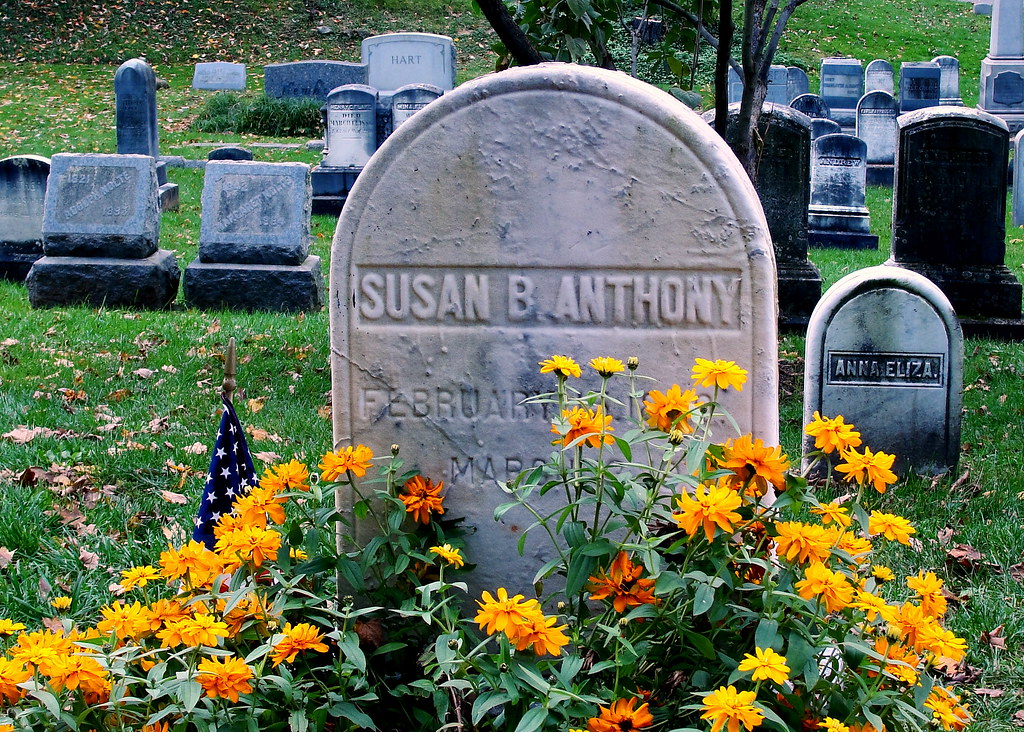
G
R
A
V
E
After March 13, 1906 - Grave of Susan B. Anthony, Mount Hope Cemetery, Rochester, New York (USA). Susan B. Anthony [1820-1906] was a social reformer & feminist who played a pivotal role in the women's suffrage movement with Elizabeth Cady Stanton (qv). Buried near Frederick Douglass (qv).
Randal Cremer

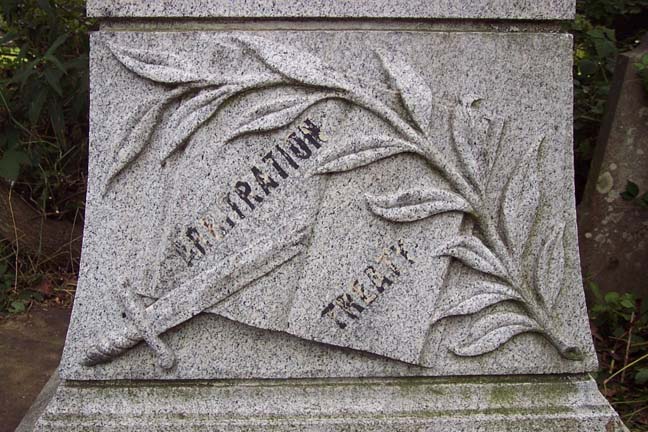

1908 - Grave of Randal Cremer, Hampstead Cemetery (plot H9/40), London, England (UK). Randal Cremer [1828-1908] received the 1903 Nobel Peace Prize. He died at his home, 11 Lincoln's Inn Fields, London (England). Click here for an article about this grave.

Henry Dunant


1910 - Grave of Henri Dunant, Friedhof Zürich-Sihlfeld (Switzerland). Henry Dunant [1828-1910] founded the International Red Cross. He & Frédéric Passy [1822-1912] received the first (1901) Nobel Peace Prize. He died in Heiden (Switzerland).

Bertha von Suttner

1914 - "Die Urne Bertha von Suttners im Columbarium des Gothaer Hauptfriedhofs" (Columbarium), Gotha (Germany). "von Suttner was a member of the Austrian Association 'The Flame,' the cremation propagated. Sie förderte den Bau des ersten deutschen Krematoriums in Gotha und verfügte testamentarisch, dass ihr Leichnam nach Gotha überführt und dort verbrannt werden solle. It promoted the construction of the first German crematorium in Gotha, and decreed in his will that her body should be burnt and there transferred to Gotha. Die Urne mit ihrer Asche wird noch heute im dortigen Columbarium aufbewahrt. The urn with her ashes are still in there Columbarium kept."

Ludwig Zamenhof


D
E
A
T
HApril 14, 1917 - Death of Ludwig Zamenhof [1859-1917], Warsaw (Poland). Image shows his grave in Okopowa Street Jewish Cemetery in Warsaw. Zamenhof created Esperanto.

S Q U A R E February 3, 1931 - Place L. Zamenhof / L. Zamenhof Square, Boulogne-sur-Mer (France). Plaque is inscribed "PLACE L. ZAMENHOF (3-2-31) To recall the First Universal Esperantist Congress (August 1905) and the memory of the creator of the Esperanto Language. (Federal Esperantist Congress 26-7-31)"
Edith Cavell



May 1919 - Grave of Edith Cavell, Life’s Green, South Wall, Norwich Cathedral, Norwich, Norfolk (England). Edith Cavell [1865-1915] was "quite the most famous woman to be killed in World War I." As a British nurse, she "treated friend and foe alike and helped allied soldiers to escape, for which she was executed by the Germans" in Brussels (Belgium) on October 12, 1915. Buried after a memorial service at Westminster Abbey on May 15, 1919. Lower image shows graveside ceremony on October 9, 2004. Upper image copyright © Martin Edwards 2003. Click here for more Cavell monuments.
Charles John Cobb
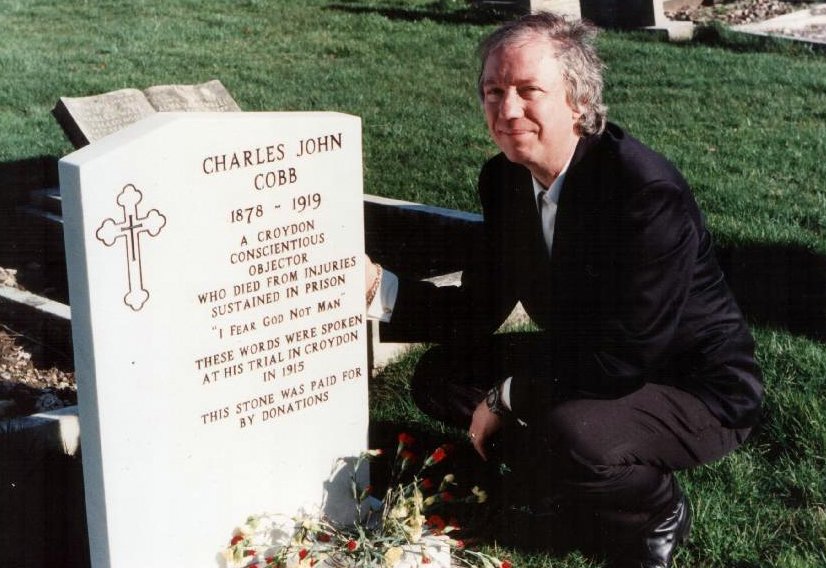

After 1919 - Grave of Charles John Cobb, Croydon Cemetery, Mitcham Road, Croydon, London (England). Inscribed: "A Croydon conscientious objector who died from injuries sustained in prison. 'I fear God not man.' These words were spoken at his trial in Croydon in 1915. This stone was paid for by donations." Info courtesy of Valerie Flessati (2012). This is 1 of 45 monuments in her "Peace Trails through London," page 19.
Jane Addams
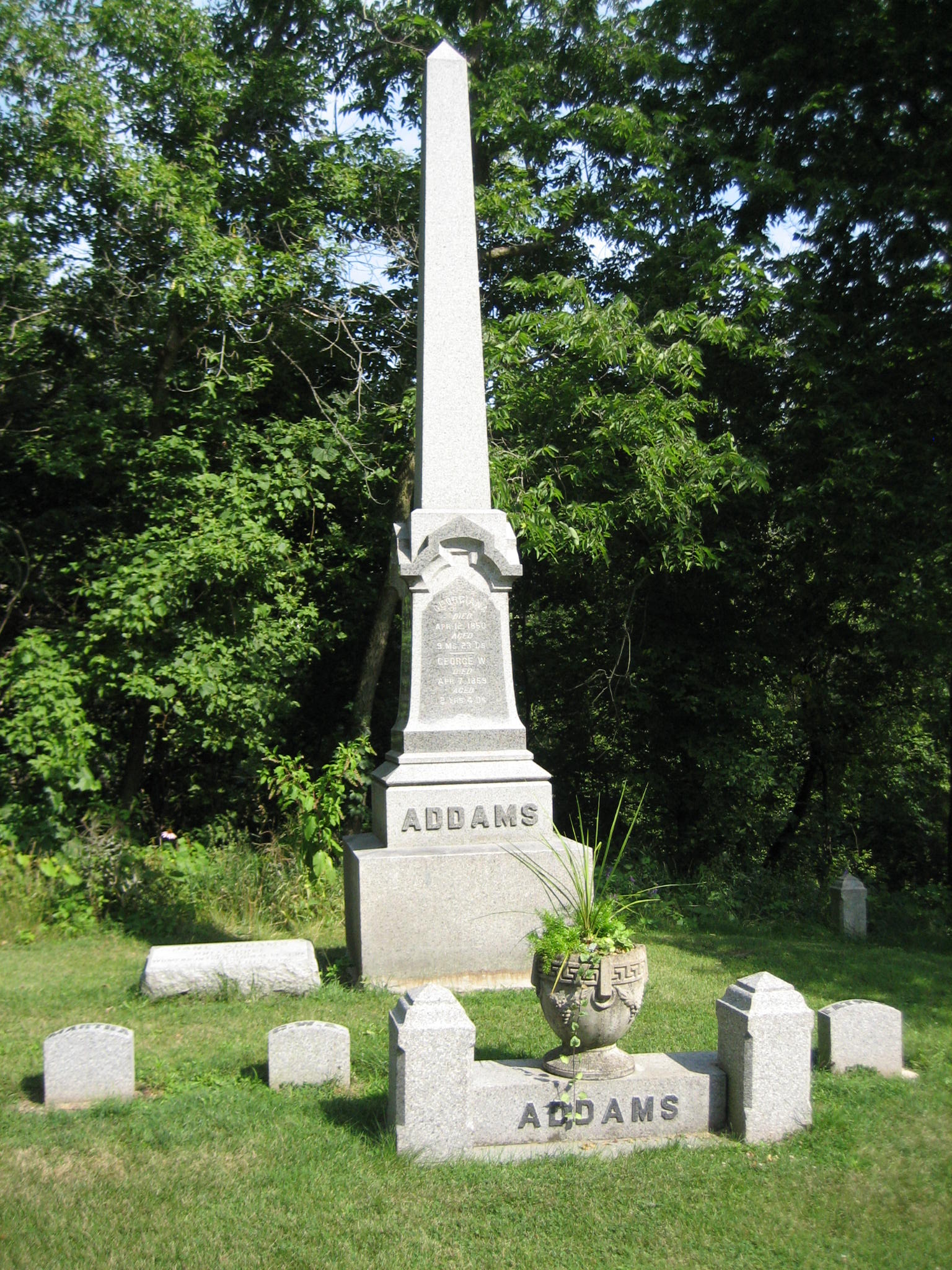
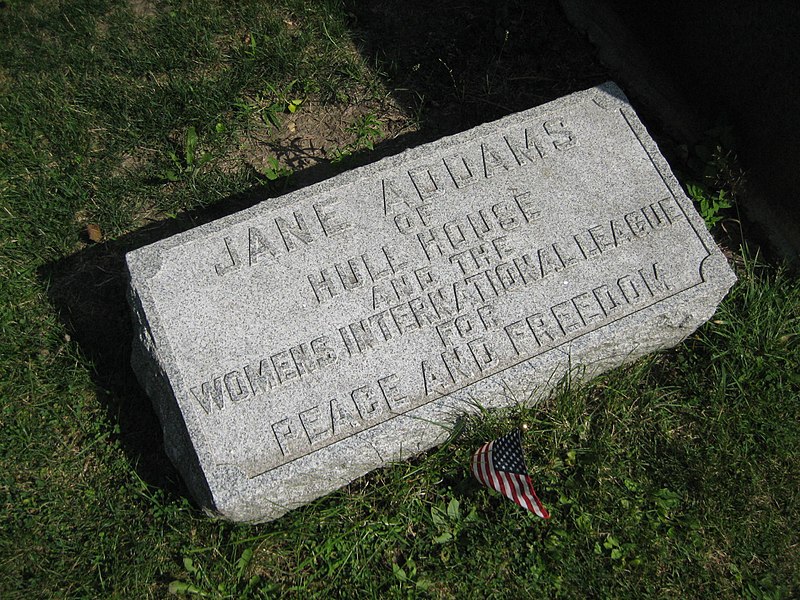


After May 21, 1935 - Grave of Jane Addams, Cedarville (30 miles west of Rockford), Illinois (USA). Addams died in Chicago. The obilisk at her grave was restored in 2004. Jane Addams [1860-1935] was president of the Women's International League for Peace & Freedom (WILPF). She & Nicholas Murray Butler [1862-1947] shared the 1931 Nobel Peace Prize. "As the first U.S. woman to win the prize, Addams was applauded for her 'expression of an essentially American democracy.'"

Emma Goldman



After May 14, 1940 - Grave of Emma Goldman, Forest Home/German Waldheim Cemetery, 863 South DesPlaines Avenue, Forest Park, Chicago, Illinois (USA). Born in Russia, Emma Goldman [1869-1940] was an anarchist known for her political activism, writing, and speeches. She played a pivotal role in the development of anarchist political philosophy in North America & Europe in the first half of the 20th century. The Haymarket Martyrs' Monument (qv) is nearby.
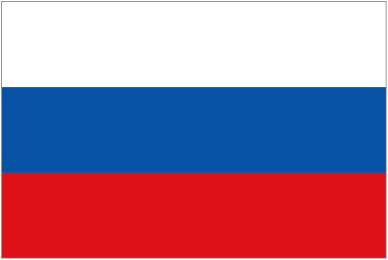
Minnie Vautrin
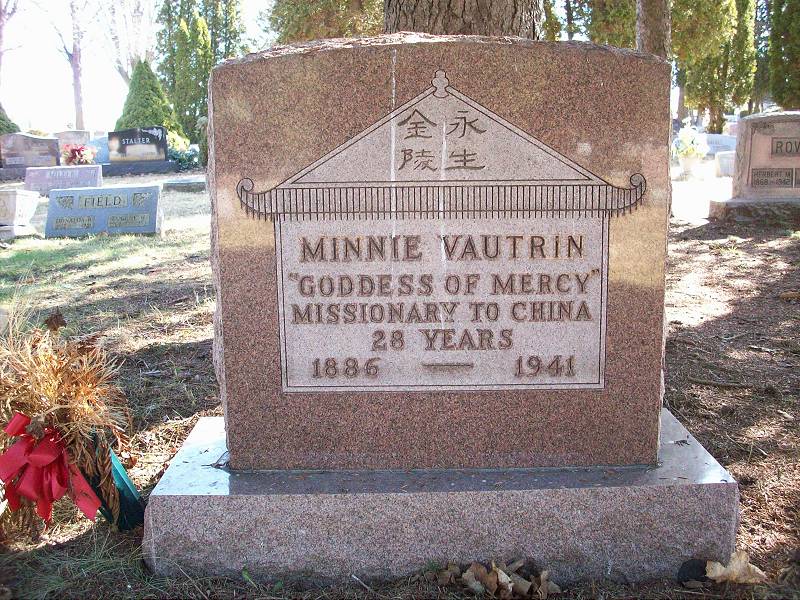

After May 14, 1941 - Salt River Cemetery, Shepherd, Isabella County, Michigan (USA). Committed suicide in Indianapolis, Indiana, while on furlough from China & attached to the United Christian Missionary Society (UCMS).

Date? - Minnie Vautrin Memorial, Secor Community Building, Secor, Illinois (USA). Bench & plaque memorializing Minnie Vautrin [1886-1941], an American missionary born in Secor, IL (population 379). Renowned for saving the lives of many women at the Ginling Girls College in Nanking, China, during the Nanjing Massacre.

December 13, 2000 - Minnie Vautrin Memorial, Ginling Girls College, Nanjing (China). Minnie Vautrin [1886-1941], was an American missionary renowned for saving the lives of many women during the Nanjing Massacre. Click here for chronology of Ginling College & Minnie Vautrin.
Franklin D. Roosevelt

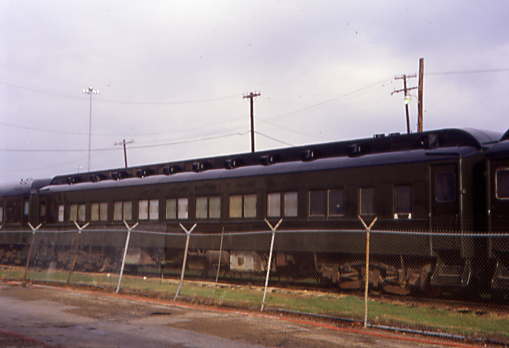



April 12, 1945 - Death of Franklin Delano Roosevelt [1882-1945], "Little White House," Warm Springs, Georgia (USA). "On the morning of April 13, Roosevelt's body was placed in a flag-draped coffin & loaded onto the presidential train [middle image]. After a White House funeral on April 14, Roosevelt was transported back to Hyde Park by train, guarded by four servicemen, one each from the Army, Navy, Marines & Coast Guard. As was his wish, Roosevelt was buried in the Rose Garden of the Springwood estate, the Roosevelt family home in Hyde Park on April 15 [right image]." /// Pullman Sleeping Car Glengyle built in 1918 which provided 1st Class accommodations for family & dignitaries on FDR's funeral train is in Museum of the American Railroad, Fair Park, Dallas, Texas.
Mahatma Gandhi
January 31, 1948 - Raj Ghat, New Delhi (India). Where Gandhi's body was cremated, and a shrine ever since. A commemorative ceremony takes place every Friday. Remembrance prayers are held on anniversaries of Gandhi's Birth ( October 2) & Death (January30). The latter is called Martyr's Day. Gandhi's ashes were sent to the Ganges, other sites in India, the Nile (Uganda) & Pacific Palisades, California (USA).

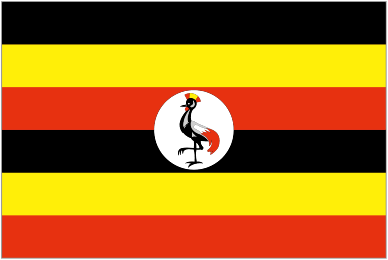

Theodor Herzl
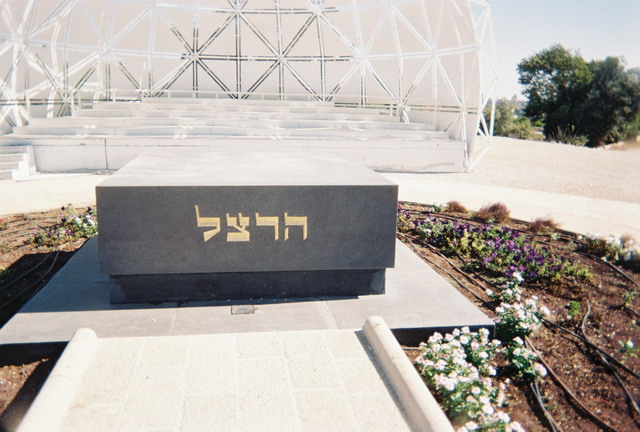


G
R
A
V
E1949 - Grave of Theodor Herzl, Mount Herzl (Har Herzl or Mount of Memory), Jerusalem (Israel). When Herzl died in 1904, he was interred in Vienna. It was only in 1949, 45 years later, that Herzl's remains were brought to Israel and reinterred in Jerusalem. Mount Herzl is Israel's national cemetery on the west side of Jerusalem. Herzl's tomb lies at the top of the hill. Israel's war dead are also buried there. Yad Vashem lies just to the west of Mount Herzl.

C
O
N
FAugust 29-31, 1897 - First Zionist Congress, Basel (Switzerland). Convened & chaired by Theodor Herzl [1860-1904], founder of the modern Zionism movement. Formulated a Zionist platform, known as the Basle program, and founded the Zionist Organization. Also adopted the Hatikvah as its anthem (already the anthem of Hovevei Zion & later to become the national anthem of the State of Israel).
Nazi Victims

C
E
ME
T
E
R
Y1952 - Gräbenfeld X / Cemetery X, Tübingen (Germany). Has military sections for WW-I and WW-II. Also "served as the cemetery for the anatomical institute of Tübingen University from 1849 to 1963. People who had donated their bodies to science were buried here. But the 1077 people who were buried here from 1933 to 1945 died as victims of the Nazi regime -- starved or killed in POW camps, in hospitals, in concentration camps, work camps, etc. More than 70 were hanged or beheaded by military courts for resistance or openly doubting military victory in the war. 44 of the people here were murdered by the German secret police without trial. 156 were POWs or forced laborers who died of various diseases or of exposure and exhaustion in their camps and were buried here after use by the anatomical institute." "The three crosses were the first indication of a memorial at this site. They were added in 1952. It is hardly visible on the photo, but they read '1939-1945,' giving the impression that this is a war memorial." Visited by EWL.
Hiroshima & Nagasaki Dead
August 5, 1955 - Atomic Bomb Memorial Mound, Hiroshima Peace Memorial Park, Hiroshima (Japan). A vault lies under the mound and contains the ashes of roughly 70,000 victims. #09 of 56 "cenotaphs & monuments" on the Virtual E-Tour. Photo by EWL.

March 1958 - Vault for the Unclaimed Remains of Victims, Peace Park, Nagasaki (Japan). Contains the skeletal remains of atomic bomb victims collected from Nagasaki City and nearby towns First dedicated in March 1958 for the repose of the victims' souls. New structure completed in June 1994.
Woodrow Wilson




1956 - Sarcophagus of Woodrow Wilson, Washington National Cathedral, Cleveland Park, Massachusetts & Wisconsin Avenues, NW, Washington, DC (USA). "Woodrow Wilson [1856-1924] was the 28th President of the US and winner of the 1919 Nobel Peace Prize. Only president buried in DC proper. Originally buried in the Bethlehem Chapel in the crypt of Washington National Cathedral. In 1956, celebrating the centennial of his birth, the Cathedral arranged for his removal to this sarcophagus in the south aisle of the nave proper. It is decorated with symbols of Princeton University (of which he was president), the state of New Jersey (of which he was governor), and the Seal of the USA. Windows of the Wilson Bay depict war and peace, commemorating his service as president during WW-I, as does the sword on the top of the sarcophagus."

Zonia Baber


1956 - Grave of Zonia Baber, Evergreen Cemetery (Section E), Lansing, Ingham County, Michigan (USA). Mary Arizona "Zonia" Baber [1862-1955] was an American geographer & geologist best known for developing a method for teaching geography. She was involved in the WILPF & many other social causes & worked to popularize peace monuments.
Sylvia Pankhurst
G
R
A
V
EAfter September 27, 1960 - Grave of Sylvia Pankhurst, Holy Trinity Cathedral, Addis Ababa (Ethiopia). "After the liberation of Ethiopia, Sylvia Pankhurst [1882-1960] became a strong supporter of union between Ethiopia & the former Italian Somaliland...In 1948, MI5 considered strategies for 'muzzling the tiresome Miss Sylvia Pankhurst.' She became a friend & adviser to Emperor Haile Selassie [1892-1975] and followed a consistently anti-British stance. She moved to Addis Ababa at Selassie's invitation in 1956, with her son Richard (who continues to live there) and founded a monthly journal, Ethiopia Observer, which reported on many aspects of Ethiopian life and development. She died on September 27, 1960, and was given a full state funeral at which Selassie named her 'an honorary Ethiopian.' She is the only foreigner buried in front of Holy Trinity Cathedral, in the area reserved for patriots of the Italian war."

Eleanor Roosevelt


November 7, 1962 - Death of Eleanor Roosevelt [1884-1962], New York City, New York (USA). "Her funeral at Hyde Park was attended by President John F. Kennedy & former Presidents Truman & Eisenhower. At her memorial service, Adlai Stevenson asked, 'What other single human being has touched & transformed the existence of so many?' Stevenson also said that Roosevelt was someone 'who would rather light a candle than curse the darkness.' She was laid to rest next to Franklin at the family compound in Hyde Park, New York, on November 10, 1962."
Martin Luther King, Jr.
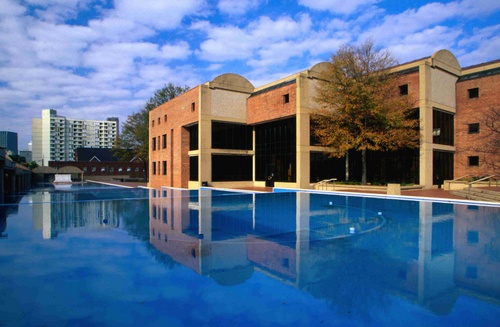

1968 - Martin Luther King, Jr., Center for Nonviolent Social Change, Inc., Atlanta, Georgia (USA). Includes King's tomb (in lake in photo), an eternal flame, Rosa Parks room, and Mahatma Gandhi room. Click here for additional information. Entry #242 in the "Peace Movement Directory" by James Richard Bennett (2001). (Martin Luther King, Jr. received the Nobel Peace Prize in 1964. He was assassinated in Memphis, Tennessee, on April 4, 1968.)

Dwight D. Eisenhower


After 1969 - Grave of President Dwight D. Eisenhower, Place of Meditation, Eisenhower Center, Abeline, Kansas (USA). Right panel quotes from Ike's "The Chance for Peace" speech of April 15, 1953: "Every gun that is made, every warship launched, every rocket fired signifies, in the final sense, a theft from those who hunger and are not fed, those who are cold and are not clothed... This is not a way of life at all... Under the cloud of threatening war, it is humanity hanging from a cross of iron."
Ralph Bunche

G
R
A
V
E
1971? - Grave of Ralph Bunche, Woodlawn Cemetery, Bronx, New York City (USA). Ralph Bunche [1903-1971] was acting UN mediator on Palestine. After eleven months of virtually ceaseless negotiating, he obtained signatures on armistice agreements between Israel & the Arab States. Bunche returned home to a hero's welcome. New York City gave him a 'ticker tape' parade up Broadway; Los Angeles declared a 'Ralph Bunche Day." He received the Nobel Peace Prize in 1950 & died December 10, 1971, at age 68. Only inscription on headstone is "BUNCHE" & two olive branches.


Carl von Ossietzky & Maud Ossietzky
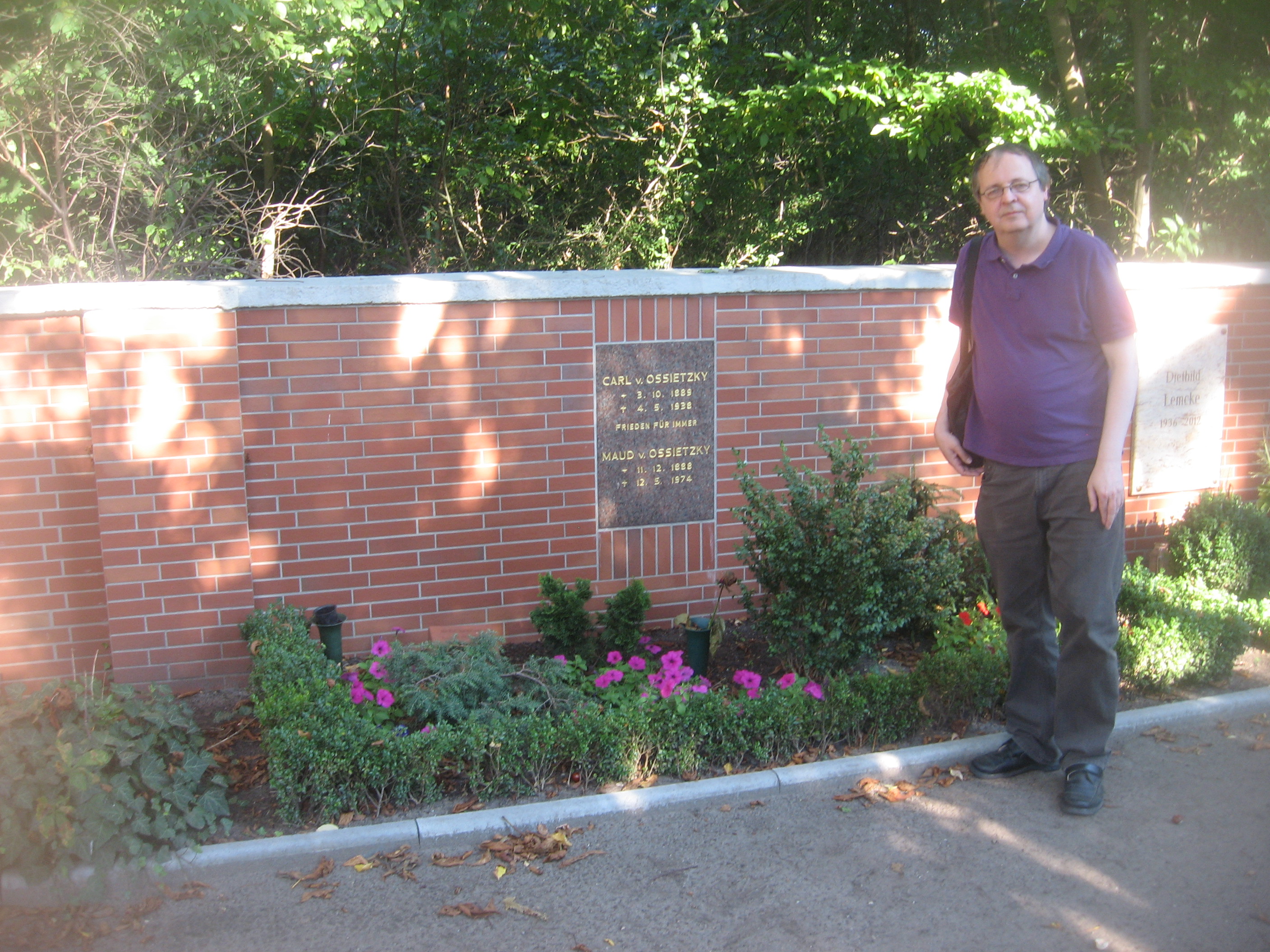
After 1974 - Graves of Carl von Ossietzky & his wife Maud Ossietzky, Friedhof Pankow IV, Niederschonhausen, Pankow, Berlin (Germany). Carl von Ossietzky [1889-1938] received the Nobel Peace Prize in 1935. Maud Lichfield-Wood Ossietzky [1888-1974] was a suffragette in Manchester (England), born a British colonial officer's daughter & the great granddaughter of an Indian princess in Hyderabad (India). Ossietzky's was the only Nobel peace prize awarded for opposing Nazism. Only inscription on plaque: "Frieden für Immer / Peace Forever." Inscription on small terra cotta marker: "Ehrengrab Land Berlin / Honorary grave, State of Berlin." Information courtesy of Christian Bartolf (who is pictured in the image made by EWL 6 Sept 2013).



1989? - Carl von Ossietzky Monument, Ossietzky Strasse, Berlin-Pankow, East Berlin (Germany).Carl von Ossietzky [1889-1938] received the Nobel Peace Prize in 1935.


Hannah Arendt


1975 - Grave of Hannah Arendt, Bard College, Annandale-on- Hudson, New York (USA). Hannah Arendt [1906-1975] was an influential German-Jewish political theorist. In 1959, she became the first woman appointed to a full professorship at Princeton University. She died December 4, 1975, in New York City & was buried at Bard College where her husband taught for many years.

Fannie Lou Hamer
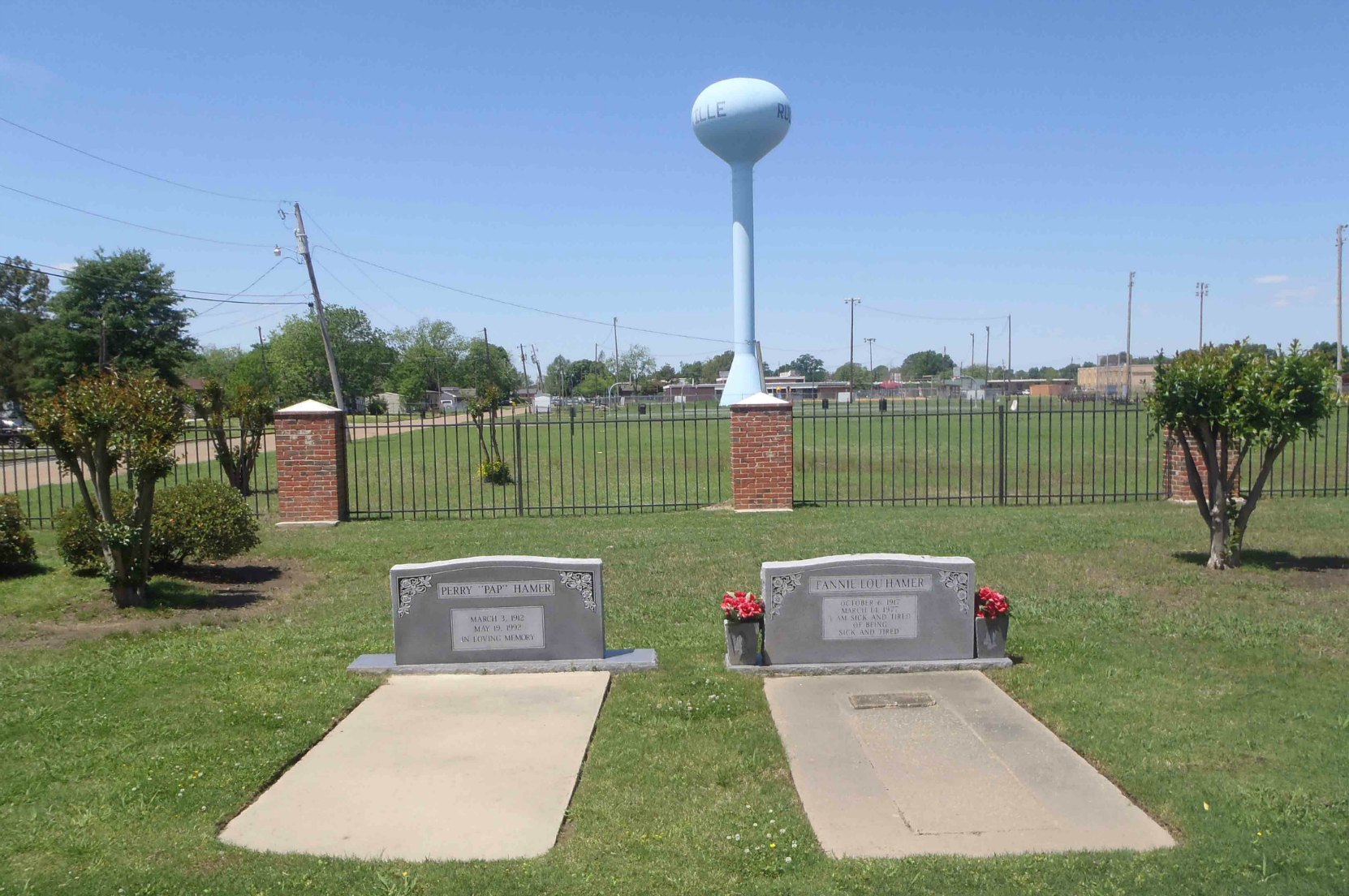

After March 14, 1977 - Grave of Fannie Lou Hamer, Ruleville, Mississippi (USA). Fannie Lou Hamer [1917-1977] was was an American voting rights activist and civil rights leader. Tombstone engraved "I am sick and tired of being sick and tired."

After March 14, 1977 - Statue of Fannie Lou Hamer, Fannie Lou Hamer Memorial Garden, 726 Byron Street, Ruleville, Mississippi (USA). Fannie Lou Hamer [1917-1977] was was an American voting rights activist & civil rights leader. Famous for saying "I am sick and tired of being sick and tired." at 1964 Democratic national convention in Atlantic City.
Anwar al-Sadat

After 1983 - Victory Memorial to the War of October 1973, Medinet Nasr, near Cairo (Eqypt). Sadat's tomb is under the Victory Memorial. Anwar al-Sadat [1918-1981] & Menachem Begin [1913-1992] of Israel shared the 1978 Nobel Peace Prize. Sadat was assassinated October 6, 1981, during the annual victory parade in Cairo. The nearby October War Panorama was built on a suggestion made to Hosni Mubarak by Kim Il Sung of North Korea when the Egyptian president visited that country in 1983.

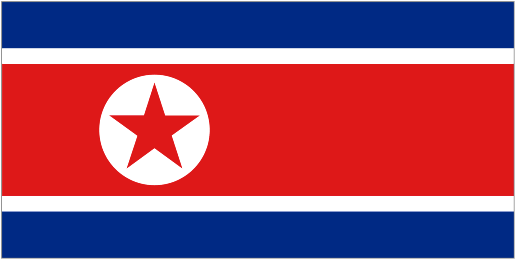
Gerald Holtom

After September 18, 1985 - Grave of Gerald Holtom, Kent & Sussex Cemetery & Crematorium, Royal Tunbridge Wells, Kent (England). Inscription: "To the memory of Gerald Herbert Holtom, A Campaigner for Peace - May He Find Peace. Died 18th September 1985, Aged 71 Years." "Gerald Herbert Holtom [1914-1985] created the CND peace symbol on February 21, 1958. At that time, he was working with the Direct Action Committee against Nuclear War. Holtom was a dedicated peacemaker & graduate of the Royal College of Arts. During World War II, he worked on a farm in England as a conscientious objector." Note peace symbols in upper corners of the tombstone.
Seán MacBride
1988 - Grave of Seán MacBride, Glasnevin Cemetery, Dublin (Ireland). Also grave of his mother Maude Gonne MacBride [1865-1953]. Seán MacBride unveiled the statue of Reconciliation at the University of Bradford (England) in 1977 (qv). Seán MacBride [1904-1988] & Eisaku Sato [1901-1975] shared the 1974 Nobel Peace Prize.

Alex Haley



1980's - Alex Haley Home & Museum (plus historical marker & grave), 200 South Church Street, Henning, Tennessee (USA). "Built in 1919 by Will E. Palmer, the maternal grandfather of Alex Haley [1921-1992]. From 1921 to 1929, & during some subsequent summers, Haley lived here with his grandparents. It was on the porch of this house that Haley heard from his grandmother the family stories that inspired him to write Roots: The Saga of an Amerian Family, retelling tales of his African ancestors who were brought to America as slaves. The work won him the 1976 Pulitzer Prize, and the book was presented in an eight- part television adaptation in 1977. Haley is buried on the grounds."
J. William Fulbright
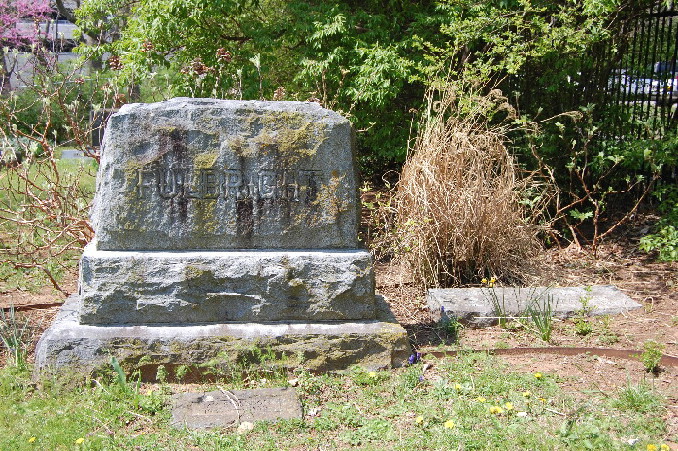


After February 9, 1995 - Grave of Senator J. William Fulbright [1905-1995], Evergreen Cemetery, Fayetteville, Arkansas (USA). Interrment of his ashes.
Yitzhak & Léa Rabin
1995 - Tomb of Yitzhak & Léa Rabin, Mount Herzl, Jerusalem (Israel). Yitzhak Rabin [1922-1995], Shimon Peres & Yasser Arafat [1929-2004] shared the 1994 Nobel Peace Prize. Rabin was assassinated November 4, 1995, in Kikar Malkhei Yisrael / Kings of Israel Square, Tel Aviv, as he was leaving a mass rally in support of the Oslo peace process.

Yasser Arafat
2004 - Mausoleum & Minaret honoring Yasser Arafat, Al-Muqata'a, Ramallah (Palestine). Right next to the presidential headquarters where Arafat spent his last years. Yasser Arafat [1929-2004], Shimon Peres & Yitzhak Rabin [1922-1995] shared the 1994 Nobel Peace Prize.

Alcatraz Martyrs
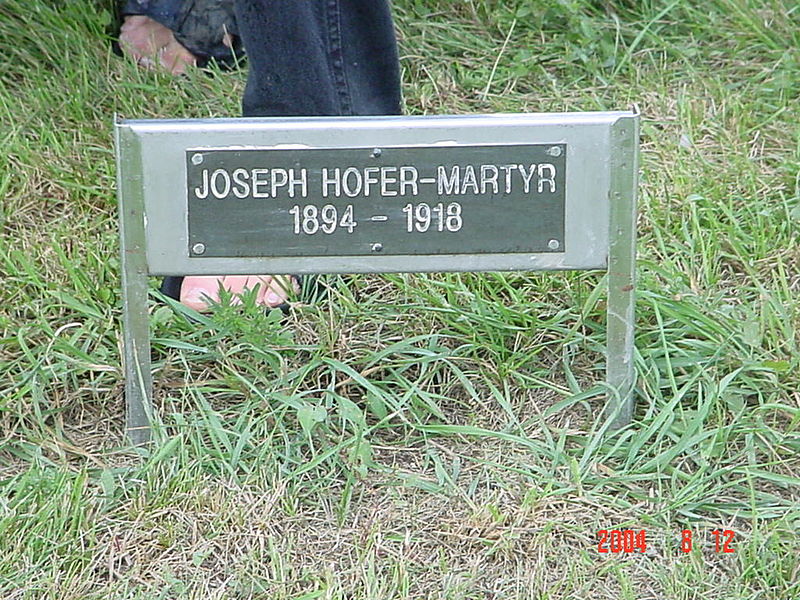

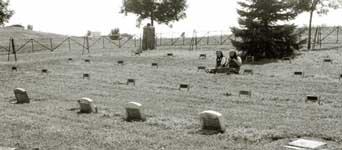


Summer 2010 - New stainless steel markers at graves of the "Alcatraz Martyrs," Friedhof/Cemetery, Rockport Colony (Hutterite), Hanson County, South Dakoka (USA). 18 miles from Alexandria, SD. Hutterites Joseph Hofer [1894-1918] & Michael Hofer [1893-1918] died as a result of "persecution [in Alcatraz & Leavenworth prisons] for their religious beliefs during World War I, in an era before alternative service was effectively implemented for conscientious objectors... The deaths of the brothers were a main catalyst for the mass movement of Hutterites [from the USA] to Canada." See books by Joanita Kant (2011) & Duane Stolzfus (2013).
Ben Salmon
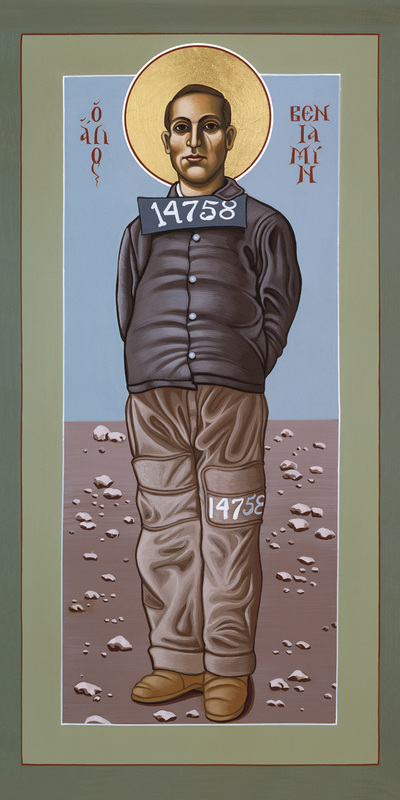
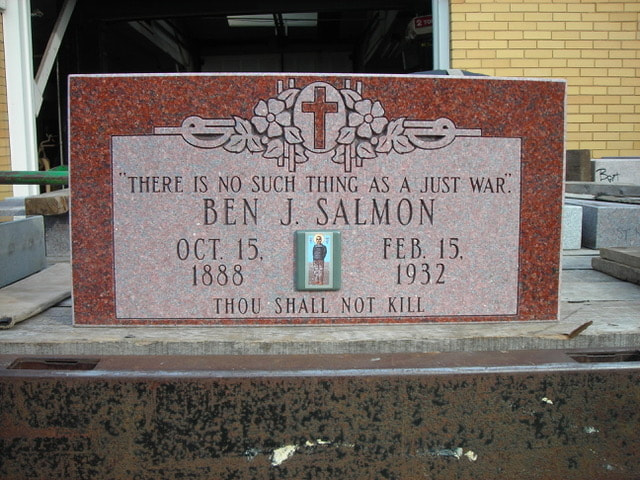
G
R
A
V
E
November 1, 2017 - Grave of Conscientious Objector Ben Salmon, Mount Carmel Cemetery, Hillside (near Chicago), Illinois (USA). "The Friends of Franz [Jägerstätter] & Ben [Salmon] collected donations to have the stone placed on Ben's unmarked grave. On All Saints Day 2017, his grave was marked with the stone shown [here]...inscribed "There is no such thing as a just war." /// Benjamin Joseph Salmon [1888–1932] was an American Christian pacifist, Roman Catholic, conscientious objector & outspoken critic of just war theory, who believed no war could be morally justified." Information courtesy of Gerard Lössbroek.
